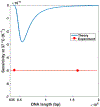Harnessing DNA for nanothermometry
- PMID: 33128802
- PMCID: PMC8009499
- DOI: 10.1002/jbio.202000341
Harnessing DNA for nanothermometry
Abstract
Temperature measurement at the nanoscale has brought insight to a wide array of research interests in modern chemistry, physics, and biology. These measurements have been enabled by the advent of nanothermometers, which relay nanoscale temperature information through the analysis of their intrinsic photophysical behavior. In the past decade, several nanothermometers have been developed including dyes, nanodiamonds, fluorescent proteins, nucleotides, and nanoparticles. However, temperature measurement using intact DNA has not yet been achieved. Here, we present a method to study the temperature sensitivity of the DNA molecule within a physiologic temperature range when complexed with fluorescent dye. We theoretically and experimentally report the temperature sensitivity of the DNA-Hoechst 33342 complex in different sizes of double-stranded oligonucleotides and plasmids, showing its potential use as a nanothermometer. These findings allow for extending the thermal study of DNA to several research fields including DNA nanotechnology, optical tweezers, and DNA nanoparticles.
Keywords: DNA; Hoechst; anisotropy; nanothermometers; temperature; thermal information.
© 2020 Wiley-VCH GmbH.
Conflict of interest statement
CONFLICT OF INTEREST
The authors declare no competing financial interest
Figures




References
-
- Baffou G; Girard C; Quidant R Mapping Heat Origin in Plasmonic Structures. Phys. Rev. Lett 2010, 104 (13), 1–4. - PubMed
-
- Donner JS; Thompson SA; Kreuzer MP; Baffou G; Quidant R Mapping Intracellular Temperature Using Green Fluorescent Protein. Nano Lett. 2012, 12 (4), 2107–2111. - PubMed
-
- Vetrone F; Naccache R; Zamarro A; Juarranz A; Fuente D; Sanz-rodrı F; Maestro LM; Martı E; Jaque D; Capobianco JA Temperature Sensing Using Fluorescent Nanothermometers. ACS Nano 2010, 4 (6), 3254–3258. - PubMed
-
- Donner JS; Thompson SA; Alonso-Ortega C; Morales J; Rico LG; Santos SICO; Quidant R Imaging of Plasmonic Heating in a Living Organism. ACS Nano 2013, 7 (10), 8666–8672. - PubMed
Publication types
MeSH terms
Substances
Grants and funding
LinkOut - more resources
Full Text Sources
Miscellaneous

